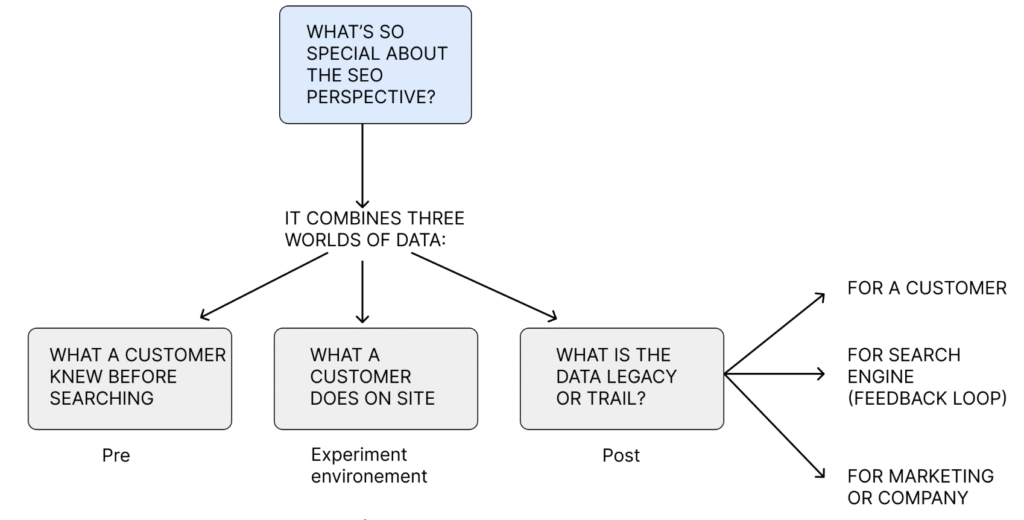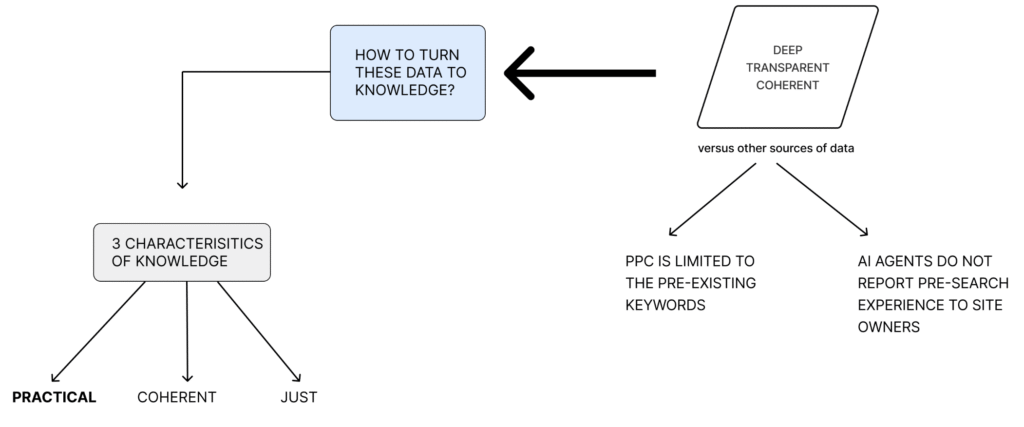Hello, my friends. My name is Bohdan and this is lesson number two from the course SEO Fundamentals and we’re addressing a topic: What is the SEO perspective?
Before starting this one, let’s go back, make a summary of what has been in the lesson one.
Summary of a previous lesson
So in lesson one, we discussed a topic, what is SEO versus what is not. So we came to the conclusion that customers from different channels of traffic come to a single site. So optimization for one channel, including SEO, must not contradict optimization for other channels or all the channels. This implies the existence of a guiding principle, in my words, customer good. The practical aspect of it is a customer utility.
So, optimization for customer utility does not equal optimization for any channel. It’s an optimization for a certain outlook or perspective. As such, customer utility doesn’t pertain exclusively to any domain, be it marketing is your product, but each of them has a certain perspective over it. Likewise, if a company has a dominant outlook, this one will define a place of SEO in the structure of the enterprise.
So we concluded that search engine optimization is an activity to increase customer utility as seen through the eyes of search engine engineers.
1. What is special about the SEO perspective?
Now let’s go to the topic: what is the SEO outlook specifically? If the website-related activity of a customer is an environment for experiment (where a customer makes choices and all his or her activity can be measured) then, the SEO perspective combines three worlds of data.

First is a pre-experiment setting or what the customer knew before coming to the website? This includes search terms and the motivation behind these terms that he put in a search engine filter before landing on a page.
The second world is an activity inside the experiment environment or the website: the journey across the website, the clicks, views and so on.
And thirdly, it’s the data legacy or data trail of this activity. So what is the trail of data that a customer leaves behind him or her? This might be interesting for:
- the customer himself,
- for search engines, which will create a feedback loop: understand, measure and reiterate the impact of this data over the next iteration
- and thirdly it’ll leave a trail for marketing or the company as a whole.
2. SEO is a source of valuable data that needs deciphering
And this brings us to the outcome that SEO, combining these three worlds, is a source of data that needs deciphering.
These data are somewhat unique.They are:
- deep because we can have a view into three large fields,
- clear or transparent because we can relatively easily attribute sessions to clicks, clicks to customers, geographies, interests etc, and
- coherent, as they can be easily brought together around one user persona or one session.
2.2. SEO advantage over PPC and AI in terms of user-related data
So they have some visible advantages over other sources of data or other channels of traffic.
For example, if we take pay per click (PPC) or performance channel, then, this advertisement is limited to a pre-existing keyword base. So what has been known to a customer (beforehand) can be explicitly defined only in the preexisting keywords.
So, you cannot bid on the unknown. There’s a list of keywords that you can select from, and this is where you bid as an advertiser. Also, this is where your feedback comes from, i.e. which keywords have been successful, and which keywords brought clients, and so on.
So, SEO and PPC have much in common as regards this first or pre-experimental setting, but the universe of keywords that’s available to PPC is much smaller. It doesn’t include the newer customer experience, the ever-increasing group of keywords and so on.
With AI or artificial intelligence agents we don’t have reporting. So artificial intelligence won’t report research experience to site owners. They don’t have the likes of Google Search Consoles, the application that Google uses.
So they would not give you – as a site owner – the outlook on what has been known to a user before coming to the website. What the type of searches or type of prompts caused the result when a customer landed on the website.
So this brings us to the conclusion that somehow SEO has an advantage over the types of traffic.
3. How to turn SEO data to knowledge?
But the question is how to turn this data into knowledge. So we have three characteristics of knowledge.

Knowledge is:
- practical,
- coherent, and
- just.
Let’s deal with the practical aspect of knowledge (a knowledge test: being practical).
4. How to tell that something is practical? What does it mean to be practical?
(Or can something be practical if we cannot agree on its utility?)
So in my definition, practical is something that all stakeholders can agree upon internally. Something that does not divide stakeholders, that can be taken for a unifying and taken fastly to execution. This is practical. If we cannot agree on something, we cannot proceed to choices or action. That’s just to say it’s not practical.
5. How can SEO bring internal alignment?
How can SEO bring internal alignment or bring the unified experience to the stakeholders? It can be done by including not only SEO-specific knowledge. This is to say, a common language that unites its different stakeholders within the company.
6. What is the difference between information and knowledge?
What is the difference between information and knowledge in this case? So, knowledge is internalized. We live with this. It’s organic, it pertains to the company itself, it’s the something that we offer to the clients.
7. What are SEO-specific and not SEO-specific data?
All right, so what is SEO specific and not SEO specific data then?

SEO operates a group of data or a group of metrics that come in from the classical SEO funnel, i.e. pages:
- known,
- crawled,
- indexed, and
- ranked in the search engine results page (SERP).
What type of elements do these metrics operate?
Apparently they operate such elements as:
- URLs or pages,
- keywords,
- impressions,
- average spot or position and
- clicks.
These elements would create a group of metrics that are SEO-specific.
What are not SEO-specific metrics?
These are composed or hybrid metrics that come from finance, products, other departments, and they combine elements with real world ones.
For example, cost, revenue, some product-related metrics, and so on as per SEO-specific metrics, for example, cost per number of indexed URLs or revenue per click. These will create internalized knowledge by implying both SEO-specific and not SEO-specific, non-technical metrics melted together.
The knowledge that has been internalised and can be something that brings a company together.
8. How can internal alignment be seen?
Then, how can internal alignment be seen or witnessed? It can be seen by you demonstrating concerted actions. So acting together or acting by a guiding principle.
How to assure internal alignment?
How can this be assured? It can be assured by acting as it’s real, such as if stakeholders are actually aligned (even if it’s unknown).
So when there’s not so much information, when all the departments or the choices by other agents to have a power to align must act as if every department has been already aligned.
9. A summary of discussion
Let’s make a summary of what we discussed right now. So first, SEO has a somewhat unique perspective. It combines three stages of customer exploration. First is what has been known to the customer a priori or before visiting the website, which is expressed in keywords and motivation behind keywords. Second, what the customer is doing on the website and, thirdly, what is the data trail of the customer.
This makes a SEO perspective of customer utility very full, clear and coherent. These are data that are valuable internally. To be able to turn this data into knowledge, the knowledge must pass a threefold test. It must be practical, coherent and just.
Practical means something that brings internal alignment, does not invoke disagreement. Internal alignment is built by melting SEO-specific technical, not SEO-specific knowledge. Internal alignment is assured by acting as if all stakeholders are already aligned, even though it’s unknown.
And finally acting aligned must be beneficial to all versus acting on its own.
Postback from Lesson 20
Customer feedback creates a foundation for continuous improvement of the organization. Innovations and improvements are the consequences of repeated circles of experiments, direct observations and learning (as referred to in the Shingo model). Yet, scientific thinking requires involvement of other employees and units in the organization.

Leave a Reply